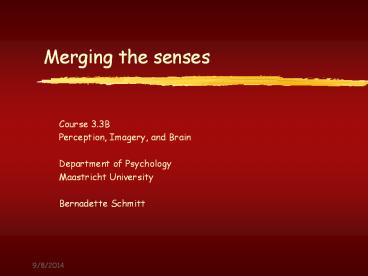Merging the senses - PowerPoint PPT Presentation
1 / 35
Title:
Merging the senses
Description:
Title: Auditory perception Author: Faculteit der Psychologie Last modified by: Faculteit der Psychologie Created Date: 12/13/1998 5:59:03 PM Document presentation format – PowerPoint PPT presentation
Number of Views:68
Avg rating:3.0/5.0
Title: Merging the senses
1
Merging the senses
- Course 3.3B
- Perception, Imagery, and Brain
- Department of Psychology
- Maastricht University
- Bernadette Schmitt
2
Merging of the senses
- Vision and Audition
- Why does watching a speakers lips improve speech
perception? (Calvert et al., 1997) - Why is there an interaction at al?
- (McGurk effect)
3
McGurk effect
4
Two stations (at least)
- Superior temporal polysensory system (STP)
- Superior colliculus
5
Kosslyns model of vision
- Input into visual buffer (retina - occipital
lobe) - parallel processing of what and where
(dorsal, ventral) - convergence of what and where in associative
memory (STP) - information lookup (dorsolateral prefrontal,
posterior parietal) - attention (superior colliculus)
6
Audition
- Analysis of sound into frequency components
- cochlea basilar membrane, haircells
- parallel processing of time and intensity
- Two parts of cochlear nucleus
- Magnocellular nucleus (time)
- Nucleus angularis (intensity)
- convergence of time and intensity
- inferior colliculus
- higher order audition
- Primary auditory cortex (frequency)
- Secondary auditiory cortex (speech sounds,
melodies)
7
From sound to vibration
- Sound wave creates vibration of the conductive
apparatus
8
The signal travels along the auditory nerve
9
The destination is the auditory cortex
6
10
Where do V and A meet?
- one hint in Kosslyn
- associative memory
- visual, auditory, and sensory information
converge - STP (superior temporal polysensory system)
11
STP location
- Superior temporal
- lobe
12
STP location
- Superior temporal
- sulcus
13
STP location
- Superior temporal
- sulcus
- dorsal bank and
- fundus
14
STP investigated
- Bruce, Desimone,
- and Gross (1981, 1986)
- single cell recording
- in Macaque
15
Properties of the STP neurons
- all responded to visual stimuli
- large receptive fields
- sensitive to movement
- sensitive to faces
- insensitive to form, size, or contrast
- 50 of the neurons also response to other senses
- 21 to visual and auditory stimuli
- 17 to visual and somesthetic stimuli (touch)
- 17 were trimodal
16
The modalityof neurons
17
Where does the activation come from?
- Afferent basis of STP (Input from)
- inferior temporal cortex (whose neurons are
visual) - superior temporal cortex (whose neurons are
auditory) - posterior parietal cortex (touch)
- Suggestion I
- STP merges the senses
18
Where does the activation come from?
- Afferent basis of STP (vision, audition, touch)
- Input from other polysensory areas
- lateral and orbital frontal cortex (association
cortex) - cingulate gyrus(attention move window)
- parahippocampal gyrus (part of limbic associaiton
cortex) - Suggestion II
- Merging of the senses happens elsewhere
19
Where does the activation come from?
- Afferent basis of STP
- Input from from other polysensory areas
- Input from medial pulvinar (Thalamic nuclei)
- Thalamus processes visual and auditory
information - pulvinar gets input from deeper layers of the
superior colliculus
20
Superior Colliculus location
- Midbrain
- Close to
- inferior
- colliculus
21
Superior Colliculus outfit
- Several layers
- superfical
- deep
22
Superior Colliculus (SC) investigated
- Wallace, Wilkinson, and Stein (1996)
- single cell
- recording
- in Macaque
23
Properties of the SC neurons
- Neurons at superficial layer responded to visual
stimuli - Neurons showed retinotopic order
24
- Retinotopic
- mapping
25
Properties of the SC neurons
- Neurons at superficial layer responded to visual
stimuli - Neurons showed retinotopic order
- sensitive to specific movement directions
- sensitive to specific velocity
- sensitive to stimulus onset or offset
26
Properties of the SC neurons
- Neurons at superficial layer responded to visual
stimuli - Neurons at deep layers
- sensitive to vision, acoustic stimuli, and touch
- multisensory sensitive to combination of
different stimuli modalities - receptive fields of different modalities match in
space
27
Properties of the SC neurons
- The visual field goes with the auditory space
28
Properties of the SC neurons
- The visual field goes with the auditory space
goes with boddy areas
29
Properties of the SC neurons
- The visual field goes with the auditory space
goes with boddy areas
30
Multisensory performance
- Multisensory neurons integrate cues from
different modalities - WHAT HAPPENS TOGETHER GOES TOGETHER
- together in time
- together in space
31
Multisensory performance (time)
- What happens at the same time goes together
- The neuron has to take into account differences
in temporal processing - Visual information comes in late auditory
information comes in early - 100 ms to visual stimuli
- 10-20 ms to acoustic stimuli and touch
- the amount of sensory interaction in a neuron
therefore depends on the onset of the stimuli
32
Multisensory performance (time)
- Time course
- of visual and
- acoustic
- interaction
- in a neuron
Visual first Acoustic second
Acoustic first
33
Multisensory performance (space)
- What happens at the same place goes together
- For example
- an object appears in front of the monkey
- a sound comes from the front of the monkey
- The neuron that is sensitive to the front fires
- But it fires in a very interesting way
34
Multisensory enhancement
35
What is the consequence ofmultisensory
enhancement?
- not sure
- but maybe in behavior
- multisensory enhancement in superior colliculus
might be one explanation for crossmodal
facilitation in perception. - It might be one answer to our initial question
- Why is it easier to understand someone if one can
watch the speakers lips?































